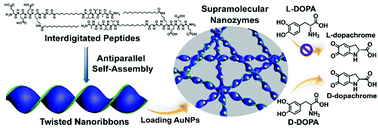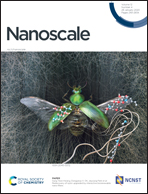Peptide interdigitation-induced twisted nanoribbons as chiral scaffolds for supramolecular nanozymes†
Abstract
Establishing reliable strategies for rationally manipulating the organization of peptide building blocks and thereby precisely creating chiral nanostructures is challenging, while meaningful toward development of advanced functional materials. Here we report on a peptide-interdigitating mechanism for the reliable self-assembly of lipid-inspired amphiphiles (LIPIAs) into robust twisted nanoribbons by grafting domains to one alkyl tail of lipids as an extended element. Peptide interdigitation promoted the self-assembly of LIPIAs into twisted or flat nanoribbons driven by antiparallel or parallel β-sheet hydrogen bonds, respectively, strongly associated with the connecting direction of the incorporated domains. We found that the LIPIAs containing N-terminus-connected domains with either bulky or small side chain groups formed twisted nanoribbons in a broad pH range, thus implying a sequence- and pH-independent strategy for creation of robust chiral nanostructures. Integrating the resulting twisted nanoribbons with gold nanoparticles led to supramolecular nanozymes exhibiting the excellent catalytic activity and enantioselectivity of asymmetric oxidation of 3,4-dihyroxy-phenylalanine molecules. Our finding demonstrates that the peptide-interdigitating mechanism is a reliable strategy for precise creation of chiral nanostructures serving as chiral matrices for supramolecular nanozymes with improved catalytic performance, thus potentially paving the way towards advanced biomimetic systems resembling natural systems.



 Please wait while we load your content...
Please wait while we load your content...